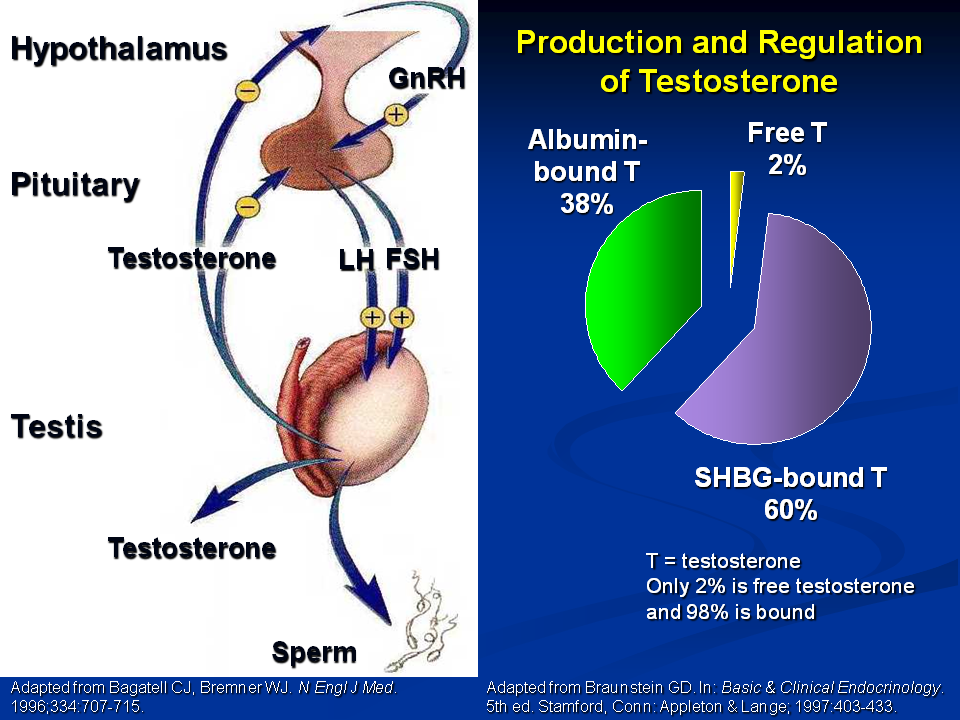Using free testosterone is best for diagnosis of low testosterone

Free Testosterone (FT) is the active form of testosterone (T) that can enter the cell. The main binding of Testosterone is to SHBG and albumin. There are different ways to determine FT. Some use free androgen index method, which is done by a calculation formula. Recently the LC/MS-MS (liquid chromatography / mass spectroscopy) has become the most widely and easy-to-use method. Free T is usually 2 percent or greater of total T. Values under 2 percent are associated with higher SHBG or albumin.
As shown in the figure above, about 2 percent of the testosterone in the body is active. This “free testosterone” is not attached to binding proteins that would prevent it from interacting with its receptor.
About 40 percent of the body's testosterone is attached to albumin. This is a protein that can release the hormone as the need for it arises in the body. Free testosterone and testosterone attached to albumin are referred to as “bioavailable testosterone.”
In a healthy young male, about 60 percent of his testosterone is attached to sex hormone-binding globulin (SHBG). Hormones bound to SHBG can't be used by the body and lose their anabolic effect. As males grow older or if an illness is present, SHBG sweeps up more and more testosterone, lowering free testosterone and its benefits.
Total testosterone is the sum of bioavailable testosterone and testosterone bound to SHBG. Measuring the total testosterone in the blood may not provide the whole picture and let you know how much “active” or usable testosterone you have.
Types of Testosterone Blood Tests- How to Choose the Best One?
A new study indicates that measuring free testosterone and total testosterone may provide a more accurate picture than measuring total testosterone levels alone when diagnosing a deficiency of this male hormone. There is concern that, under current clinical guidelines, some men are misdiagnosed with testosterone deficiency and receive inappropriate therapy. In contrast, others who should get treatment don't receive it, D.r Leen Antonio (University of Leuven, Belgium) explained when presenting her research here at the European Congress of Endocrinology (ECE) 2015.
"I think it would be preferable to use free testosterone rather than total testosterone to measure deficiency, especially in men with borderline total testosterone levels. Our results suggest that free testosterone is more informative than total testosterone," she told attendees.
Currently, total-testosterone levels are used to measure testosterone deficiency or hypogonadism. However, she explained that only free testosterone, unbound by sex-hormone–binding globulin (SHBG), can enter and activate androgen receptors in cells, resulting in testosterone-mediated effects.

Nelson Vergel is a chemical engineer who started his search for cutting-edge health knowledge when he was diagnosed with HIV over 30 years ago. Instead of giving in to the hopelessness of the deadly diagnosis, he pushed himself to explore therapies to combat wasting syndrome to save his life and those of his peers. He reviewed medical literature and attended numerous health conferences, eventually becoming an advocate member in the National Health Institute (NIH), pharmaceutical research committees, and FDA review panels. To spread survival knowledge, he has given health-related lectures, providing over 700 of them since 1987. Nelson has created popular health forums with over 55,000 members...
- Affordable Blood Tests (20)
- Anemia Tests (5)
- Annual Physical Tests (1)
- Blood Type (1)
- Blood Typing (0)
- Bodybuilder Blood Work (18)
- Bodybuilder lab tests (12)
- Buy Blood Tests Online (14)
- CBC Lab Panel (14)
- CMP blood test (19)
- CPK Levels (1)
- Cancer Tests (3)
- Celiac Disease Tests (1)
- Cholesterol (6)
- Coagulation Tests (1)
- Consumer Advocacy (1)
- Cost of Blood Work (7)
- Coupons (1)
- DHEA Lab Test (2)
- DHT Test Information (3)
- Diabetes Lab Tests (6)
- Discount Lab Tests (17)
- Discounted Labs Coupons (2)
- Electrolite Tests (1)
- Electrolyte tests (2)
- Erectile Dysfunction (7)
- Erectile Dysfunction Lab Tests (9)
- Español (1)
- Estradiol Estrogen Tests for Men (14)
- Estradiol Test (16)
- Exercise (3)
- FSH Fertility Test (4)
- Fasting blood tests (10)
- Fatigue Blood Tests (25)
- Ferritin lab test (6)
- Fertility Tests (0)
- Free T3 Thyroid Test (13)
- Free T4 Thyroid Test (14)
- Free Testosterone Test (12)
- Gift Certificate Discounted Labs (2)
- Growth Hormone Level (2)
- Gynecomastia tests (5)
- HCG Use in Men (2)
- HDL Cholesterol Test (9)
- HIV Blood Test (0)
- Heart Disease Blood Tests (14)
- Heavy Metals Test (2)
- Hepatic Function Panel (3)
- Hepatitis Tests (0)
- High Hematocrit (16)
- Hormone Blood & Lab Tests (19)
- How to Order Discounted Lab Tests Online (4)
- IGF-1 Lab Test (2)
- Immigration Tests (2)
- Immunity (0)
- Immunity tests (6)
- Inflammation Tests (18)
- Kidney Function (8)
- LH Lab Test (2)
- Lab Test Descriptions (8)
- Lab Test Education (17)
- Lab Test Normal Ranges (4)
- Lab Test Video Education (1)
- Lab Tests for Children (1)
- Labs Near Me (8)
- Libido Options for Men (10)
- Lipids cholesterol tests (7)
- Low Free T3 (2)
- Low Magnesium Symptoms (1)
- Magnesium Deficiency (1)
- Magnesium Test (1)
- Meaning of low and high lab test values (11)
- Men's Health Lab Tests (28)
- Natural Testosterone (11)
- Nutrition and Supplements (0)
- Parathyroid PTH test (1)
- Pregnenolone Test (1)
- Progesterone (1)
- Prolactin Lab Test (2)
- Prostate Tests (6)
- Reverse T3 Thyroid Test (9)
- SHBG Lab Test (2)
- STD test Information (0)
- Saliva Tests (1)
- Sex Hormone Binding Globulin SHBG Test (3)
- Sperm Lab Test (2)
- TB Test (5)
- TBG lab test (2)
- TRT App to Track Response (1)
- TRT Blood Tests (48)
- TRT Guidelines (7)
- TRT Monitoring (33)
- TRT Side Effects (45)
- TRT Testing (30)
- TSH Thyroid Test (14)
- Testicular Atrophy (2)
- Testosterone Blood Tests (57)
- Testosterone Book (1)
- Testosterone Doctor (9)
- Testosterone Lab Tests (55)
- Testosterone Replacement Monitoring Tests (33)
- Testosterone Side Effect Management (49)
- Testosterone TRT Forums (6)
- Testosterone Tests (63)
- Testosterone in Women (14)
- Thyroid Lab Tests (15)
- Thyroid Tests (17)
- Urine Tests (1)
- Vitamin Blood Tests (14)
- Women's Hormone Tests (23)
- complete lab test panel (10)
- lab tests for women (23)
- liver tests (9)
- muscle diseases (4)
- viral illness (4)









